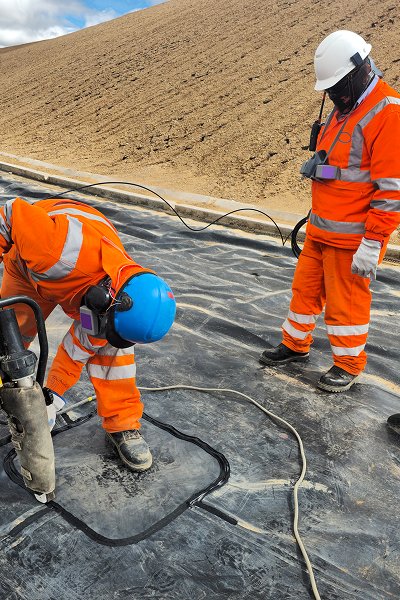Overall framework of geocell testing
Physical Properties Testing
Appearance and Dimensions: Weld spacing, cell height, unfolded length, sheet width, etc.
Sheet Thickness: Whether the thickness is uniform across different locations and meets design requirements.
Density Testing: Whether the raw material density meets the standard values for HDPE, PP, etc. (HDPE: 0.935–0.960 g/cm³).
Mechanical Properties Testing
Weld Strength: Welding quality directly determines the stability of the honeycomb structure.
Sheet Tensile Strength and Elongation at Break: Reflect the sheet's load-bearing capacity and ductility under load.
Tear Strength: Ensures that the cells are resistant to tearing during construction and under load.
Overall Compression and Shear Resistance: Verify the overall load-bearing capacity of the geocell under filler load.
Mechanical Properties Testing
Weld Strength: Welding quality directly determines the stability of the honeycomb structure.
Sheet Tensile Strength and Elongation at Break: Reflect the sheet's load-bearing capacity and ductility under load.
Tear Strength: Ensures that the cells are resistant to tearing during construction and under load.
Overall Compression and Shear Resistance: Verify the overall load-bearing capacity of the geocell under filler load.
Sheet Tensile Properties Testing
Test Purpose
Evaluate mechanical properties: Determine whether the sheet can withstand tensile forces without breaking under operating conditions.
Compare material differences: Compare the tensile properties of sheets of varying materials, thicknesses, or production processes.
Quality Control: Verify consistency and conformity during the production process.

Mechanical properties of geocells of different heights
50mm: Lightweight, suitable for surface stabilization and landscaping projects.
75mm: Between lightweight and medium load-bearing, commonly used in landscape architecture and light-duty roads.
100mm: The most common height, suitable for most road and railway bases.
150mm: Suitable for soft foundation treatment and areas with heavy loads.
200mm: Suitable for scenarios requiring high load-bearing capacity, such as heavy-duty transportation, port yards, and flood control projects.
Effect of geocell height on engineering performance
Increased Bearing Capacity
The greater the height, the more significant the increase in bearing capacity.
The geocell's honeycomb structure restricts the lateral flow of filler, resulting in a "whole-body" load-bearing effect when subjected to load. As the height increases, the volume of filler confined increases, resulting in a stiffer composite layer, significantly improving the foundation's bearing capacity.
Comparison Notes:
50mm Height: Suitable for light loads, such as sidewalks and garden paths. The increase in bearing capacity is limited.
100mm Height: Commonly used in road and railway bases, effectively supporting vehicle loads.
150-200mm Height: Excellent performance for heavy loads, such as those associated with heavy vehicles and port yards.
Controlling Soil Lateral Displacement
Lateral displacement is a major cause of foundation settlement and structural instability. The higher the cell height, the stronger the honeycomb walls' restraint on the filler, effectively reducing lateral dispersion under load.
Larger cell heights (e.g., 150mm, 200mm) can significantly reduce lateral deformation and slow differential settlement in foundations such as soft soils and collapsible loess.
Lower cell heights (e.g., 50-75mm) are primarily used for surface reinforcement and have limited effectiveness in controlling lateral displacement.
Filler Requirements and Material Savings
Increased height means increased filler volume, requiring more sand, gravel, and other fillers during construction, which in turn increases project costs.
50-100mm: Reduces filler requirements and speeds construction, but has limited durability.
150-200mm: Requires more filler and costs more, but offers improved overall stability and longevity.
Erosion Resistance and Protection
50-75mm: Suitable for slope greening and light rainwater erosion environments.
100-150mm: Resists moderate water flow and is commonly used for riverbank and ditch protection.
200mm: Exceptional performance in high-energy water flow environments such as flood control dams and seawall revetments, effectively preventing soil loss and water damage.




Can geocells be reused after construction?
Key Factors Affecting Reusability
Construction Method
Geocells secured with large amounts of adhesive (such as cement, mortar, or asphalt) are virtually impossible to recycle.
Secured with anchors, reinforced piles, or filler (sand, gravel, or soil), geocells have a certain chance of being recyclable after removal.
Filling Conditions
Sand and gravel fillers: Removal is difficult and may damage the cells.
Lightweight soil or planting soil fillers: Removal is easier and offers a high degree of reuse potential.
Use Environment
High-load environments such as roads, storage yards, and mining areas expose cells to long-term pressure, making them susceptible to deformation and limiting their reuse potential.
Light-load environments such as slope landscaping and soil and water conservation expose cells to less stress and offer a higher potential for reuse.
Service Life
Newly laid geocells typically retain good strength within 1-3 years of installation, and if they need to be removed for project adjustments, they can be reused.
After 5-10 years of use, the material degrades (especially when exposed to UV rays), making reuse less likely.

Whether geocells can be reused depends on the project type and usage environment. In temporary roads, slope greening, and light-load projects, geocells have some potential for reuse. However, in long-term, heavy-load projects such as highways, mining roads, and water conservancy dams, it is generally safer and more reliable to consider them disposable.
From an economic and sustainable perspective, reusing geocells can reduce project material costs and waste emissions to a certain extent, aligning with the green, environmental, and recycling philosophies currently advocated in engineering construction. However, in practical applications, it is necessary to balance dismantling and cleanup costs to avoid increased maintenance costs due to performance deficiencies caused by reuse.
During the design and construction phases, the utilization of geocells should be scientifically determined based on the project's load requirements, environmental conditions, and budgetary constraints. In the future, with the improvement of materials and advancements in recycling technology, the reuse value of geocells is expected to further increase, providing more economical and environmentally friendly solutions for engineering construction.


